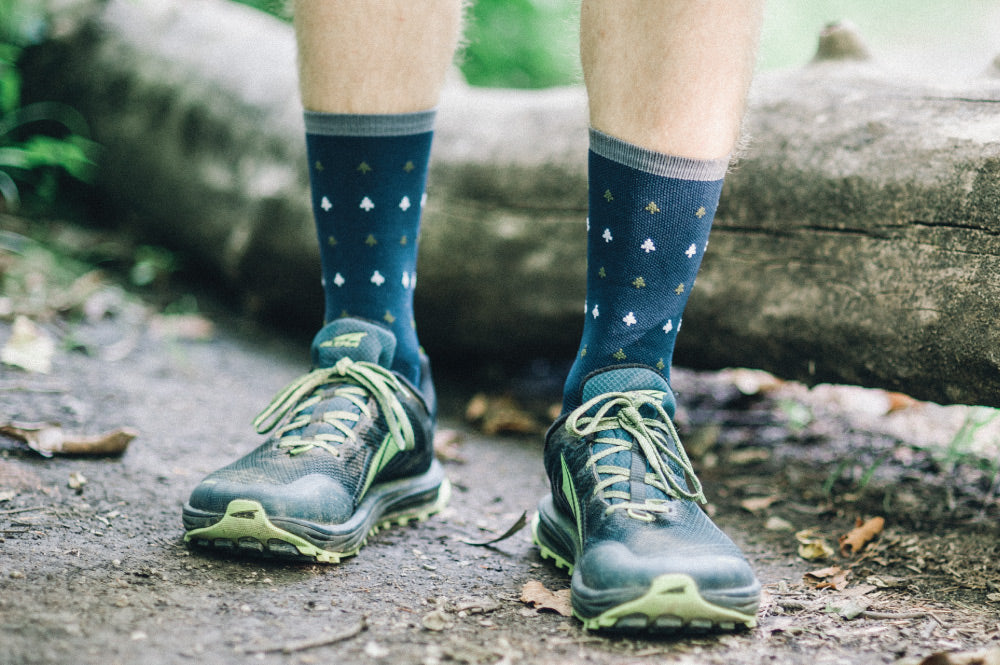The Simple Pattern of Left and Right

Aaron Burrick
Bilateral stimulation, or the rhythmic activation of the left and right sides of the body, has been shown to boost creativity, enhance problem-solving, and aid in emotional processing.
My best thinking happens when I’m scrambling over rocks, vaulting over streams, and hopscotching my way across a living maze of bark-lined roots. There’s a deep comfort in muddy ankles, muddier shoes, and my growing collection of salt-stained trucker hats. There’s peace in the blurry tunnel of green that forms around my peripheral vision, and there’s immense joy in the way my girlfriend and I clap and sing to keep the bears at bay.
On the surface, none of this seems to make sense. When running downhill, how could I possibly think of anything but keeping myself upright? When covered in mud, sweat, and whatever mysterious piece of nature is making my legs itch, how could I possibly feel comfortable? Where is the peace in a high-speed chase against myself, and where’s the joy in saying hello to a two hundred fifty-pound neighbor with claws and big teeth? As trail runners, we spend our lives trying to explain this strange, beautiful sport and all of its apparent contradictions. We send text messages when we get back to the car, promise not to break ankles on remote sections of the PCT, and try to put words to what makes us feel so full, so happy, and so free.
I started asking myself these questions two years ago when I finished graduate school, accepted my dream job, and moved to Seattle to work as a school-based mental health counselor. I’d spent the past two years studying bilateral stimulation and how, like in the REM phase of mammalian sleep, activating the left and right sides of the body and brain can have widespread positive effects on one’s thoughts, feelings, and behaviors. I knew how it worked in the therapy office, and I could happily explain it down to the last neuron, but I never thought about how it showed up on the trail. I never thought about how much the simple pattern of left-right-left-right could change trail runners’ lives.
It happens whenever we escape into the shadows of evergreen trees and old growth forest. It happens when we circle the base of Mount Rainier on the Wonderland Trail. It happens along the escarpment of the Oregon Coast, when the brush clears and you aren’t quite sure where the sky ends and the ocean begins. It happens with friends, loved ones, and training buddies, and it explains why many of our best conversations happen through quick breaths and quicker speeds. We usually feel better after a run, but not because of any calorie burn or elusive runner’s high. We feel better because, through bilateral stimulation of the body and brain, running allows us to rebuild, strengthen, and improve the ways we understand ourselves and interact with the world.
I connected the dots, and all of those contradictions suddenly made sense. The sound of my feet, leaving only footprints as I explore a new trail on Tiger Mountain. The constant, back-and-forth scanning of the ground before me, hoping to honor those promises about not breaking my ankles. The movement of my arms, keeping balance as I dare just a little more than I probably should. The way these movements, these meditative patterns of left-right-left-right, allow me to think, feel, and be in ways that I haven’t experienced anywhere else.
In a world where most side to side movement happens on computer screens, there is something incredibly powerful and life-altering in running outdoors. Our brains are built to benefit from tough climbs, rapid descents, and rolling hills. We are wired to forge new pathways, on the trails and in our minds, toward the next great peak, memorable conversation, and beautiful realization that life is full, ours, and decidedly worth living.
--
Aaron Burrick is a trail runner, writer, and clinical social worker living in Issaquah, WA. You can find him on social media @aaronburrick and online at www.aaronburrick.com.